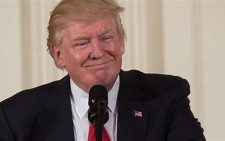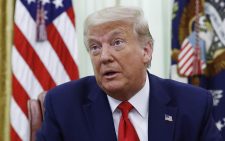How Trump’s tariffs place Kenya’s digital dream at risk

Kenya’s dream of becoming Africa’s digital powerhouse is facing a harsh new reality. Donald Trump’s revived tariffs are shaking the foundations of a tech sector that had just begun to take flight, threatening to undo years of innovation and investment.
The punitive trade shift—part of a broader retreat into economic nationalism—has ensnared Kenya despite its historical alignment with US trade policy. While the tariffs target traditional sectors like textiles and agriculture, their impact is rippling into high-technology territory, destabilizing startups, derailing growth strategies, and inflating costs.
Startups in Nairobi’s innovation spaces like iHub, Gearbox, and the Kenya Industry and Entrepreneurship Project are already feeling the heat. Companies in AI, fintech, and edtech that depend on US-made hardware or cloud infrastructure face rising costs and tighter margins.
GPU prices have increased by over 30 per cent since the start of the year, according to tech industry analysts. Essential software licenses and subscription services from US providers now cost more, and funding from US-based incubators is being reconsidered.
These changes come at a critical time. Kenya’s digital economy is projected to contribute 7 per cent of gross domestic product (GDP) by 2025. Yet, with the African Growth and Opportunity Act (Agoa) under threat, the policy foundation that underpinned this projection is crumbling.
Trump’s signals that bilateral deals should replace multilateral frameworks like Agoa have thrown Kenya’s trade positioning into uncertainty, undermining investor confidence and long-term planning.
The underlying trigger includes US frustration over Kenya’s thriving second-hand clothing market and unaddressed supply chain corruption. But the consequences go far beyond textiles. Kenya is paying for policy missteps and overreliance on US goodwill. The tech sector, built on global collaboration, is now collateral damage.
Export-oriented tech startups are particularly vulnerable. The US has long been a key market for Kenyan software services and digital products. Now, venture capital firms and accelerators—key growth partners—are re-evaluating their engagement.
Concerns over regulatory hurdles, rising transaction costs, and political risk are driving capital elsewhere. According to Partech’s 2025 Africa VC report, Kenya saw a 15 per cent dip in US-origin tech investment in the first quarter of the year.
Education programmes are also at risk. US-backed skilling initiatives, coding bootcamps, and cloud credits that helped thousands of Kenyan youth enter the digital economy are being scaled down. Data from the Ministry of ICT and Digital Economy shows a 22 per cent drop in US-sourced digital training grants in Q1 2025 alone.
Several training initiatives have paused due to funding delays, leaving students in limbo and training centres without direction. Symbolically, the damage is just as serious. The tariffs undermine two decades of partnership messaging that positioned the US as a champion of Africa’s digital leap. Now, many in Kenya feel abandoned.
The government’s response—pivoting to the African Union and rallying regional support—shows diplomatic effort. But the continent lacks a coordinated response. The African Continental Free Trade Area (AfCFTA) offers potential as a regional growth engine, but its tech capacity, infrastructure, and investment ecosystem remain underdeveloped.
Still, not all is lost. Some see this as a turning point for Kenya to reimagine its tech architecture. “This is a wake-up call,” says Mercy Kimalat, the CEO of the Association of Startup and SMEs Enablers of Kenya. “We’ve been too dependent on American platforms and pipelines. It’s time to go local.”
There is renewed interest in local fabrication labs, regional data centers, and policy-driven innovation ecosystems. Organisations like the Kenya Advanced Institute of Science and Technology (KAIST) are accelerating efforts to build domestic R&D capacity.
Government-backed initiatives to support Kenyan-owned cloud providers through procurement incentives and tax relief are being considered. At the same time, regional digital cooperation under AfCFTA is slowly gaining momentum, aiming to make cross-border scaling more feasible for tech startups.
Worse still, the geopolitical implications could reshape Africa’s entire digital future. As Al Jazeera warned, Africa may now lean harder on China, which has stepped up to provide infrastructure loans and digital platforms with fewer strings attached. This shift raises new questions about surveillance, data sovereignty, and technology standards. Caught between these giants, Kenya’s challenge is now existential. It must secure digital independence without isolation. That means investing in homegrown innovation while negotiating fair terms globally. It also means protecting emerging sectors from external shocks and creating trade policies that reflect the country’s 21st-century priorities.
The idea of Kenya as “Silicon Savannah” cannot be reduced to hype. For a growing number of youth, the digital economy is not just a sector—it’s the future of work, education, and public service. The damage caused by these tariffs is not abstract; it’s visible in broken supply chains, halted projects, and shrinking opportunities.
Trump’s tariffs may be about global power play, but in Kenya, their impact is local and personal. For thousands of young innovators, it’s not just about lost revenue—it’s about lost time, momentum, and hope.
Still, if there’s one strength Kenya has shown time and again, its resilience. This moment, however, painful, could catalyse a shift toward greater technological self-reliance. But that shift requires bold leadership, stronger institutions, and a clear-eyed understanding that the global digital economy will not wait for those who can’t adapt.
The Writer is a Machine Learning Researcher and Technology Policy Analyst.














